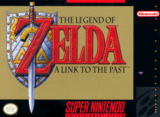May the way of the Hero lead to the Triforce...
While Ocarina of Time is often hailed as the greatest game of all time, many of its gameplay mechanics, items, and locations can trace their origins to A Link to the Past. It is here that the "two-world" mechanic is first introduced, alongside other Zelda staples such as Kakariko Village, the spin attack, and even Ganondorf Dragmire. And I would be remiss in my duties if I didn't mention that the manic swarm of killer chickens also appears for the first time, should you introduce one of your feathered friends to the Master Sword…
A Link to the Past also establishes much of the actual legend associated with the Zelda games, and for the first time, it's not limited to a brief introduction at the beginning of the game. This is the first Zelda game to actually tell a story over the course of its many dungeons, and while it's not nearly as epic as Ocarina of Time or Twilight Princess, it gives A Link to the Past far more structure than its predecessors. Conversely, the game is still reasonably open-ended, and it never feels like you're being forced into doing anything because the plot dictates that is what you must do next. In fact, it is still quite possible (though rather difficult) to beat the dungeons in the Dark World out of sequence. However you choose to proceed, the story provides the impetus you need to get there. Alas, if that isn't reason enough to take sword in hand and conquer the next dungeon, the prospect of expanding Link's arsenal just might.
Link has at his disposal a great many new items in A Link to the Past-such as the hammer, the ice rod, and the hookshot. While many of the items in Twilight Princess rarely proved useful outside the temple they were found in, the myriad items in A Link to the Past repeatedly prove their value. The boomerang, for example, was essentially forgotten after the Forest Temple in Twilight Princess, but in A Link to the Past, it is a staple in Link's arsenal right up until the very end. Locating these items is an essential part of Link's quest, and while most of them are hidden away in the game's many dungeons, there are several extremely useful items stashed away in some dark, dank cave, just waiting for you to discover them.
And discover them you must, because you will need every advantage you can get if you wish to fully explore the Kingdom of Hyrule. In A Link to the Past, Hyrule is a vast and sprawling kingdom, bustling with activity at every turn--unlike the desolate Hyrule Field in Ocarina of Time or the Great Sea in Wind Waker--and just when you think you've seen everything that Hyrule has to offer, Link will suddenly get transported to the Dark World, Hyrule's dark and twisted twin, which is every bit as expansive as its lighter counterpart (and has skeletal chickens for you to torment). Add in the fourteen expertly crafted dungeons and you have yourself a Zelda game without an equal in terms of scope.
No Zelda game is complete without puzzles, and with the aforementioned fourteen dungeons, puzzles are abound in A Link to the Past. The game also exploits the Light World/Dark World mechanic to its advantage, creating some utterly confounding moments as you shift between worlds. The solutions often require some thinking, and sometimes require a little bit of dumb luck, but are never so difficult that you throw your controller across the room. While the puzzles are often tough as nails, the enemies themselves are not. While many of the enemies still hit hard, A Link to the Past has notched down the difficulty when compared to its predecessors. The roomfuls of stalfos or gibdos you encounter in A Link to the Past are nothing compared to terrors wrought by the blue darknuts in the original game.
On the visual front, A Link to the Past presents a reasonably simple, bright and colorful world (or dark and gloomy, as is the case in the Dark World). The graphics aren't even close to the best efforts the SNES had to offer, but even so, they deftly convey the game's vast and diverse environments… and much to their credit, the graphics have aged surprisingly well.
The music, on the other hand, is absolutely phenomenal. Koji Kondo provides what is easily the best Zelda soundtrack in existence. The samples are certainly dated, but the composition of the music itself easily rises above that mediocrity, and introduces some of the finest, most memorable music Zelda has ever seen--Hyrule Castle, Zelda's Lullaby, Kakariko Village, the Dark World… they are all of them quintessential pieces of Zelda music, and each one of them had their origins in A Link to the Past.
A Link to the Past is the pinnacle of the two-dimensional Zelda games. It took everything that was great about its predecessors, refined them to the point of excellence, and placed the groundwork for every Zelda game since. Its lengthy quest, challenging puzzles, and incredible presentation combine to make it one of the greatest video games ever made. It is true indeed--the way of the Hero leads to the Triforce…

